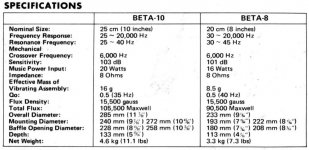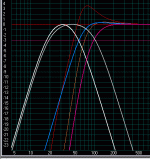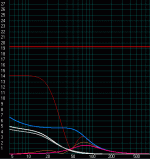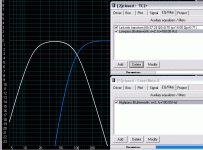The 15" isn't necessarily less accurate, but does roll off more quickly near 80 hz. It apparently works better with 60 hz crossover as opposed to 80 hz. That being said, it is really only a concern at max SPL since the servo should take care of this with anything below max SPL. The advantage of the 15" is an additional 5 dB over the 12".
Hi, I already ordered a DS12 sealed, and intend to build the enclosure as per rythmik's plans. My main speakers are Coral Beta 8s in a bass reflex tuned to 30Hz (assume this cannot change). I have done a freq plot, and it drops pretty quick at 50Hz with a much smaller peak at 30Hz. I am thinking of doing a passive high-pass for the main speakers and tune the sub from there for best sound quality (it's a mainly audio setup). Any suggestions on how best to integrate the sub, and how to get it right?
thanks, cheers!
thanks, cheers!
Yes, I recommend Win ISD pro alpha. You need to enter in net box volume and enter in driver parameters. If you don't have all parameters, then follow the info in the help menu with entering driver TS parameters. You can also do the standard version of WinISD but the pro version is far superior.
pengboon,
Paul Spencer certainly has the right idea, in that WinISD Pro will help you model things, and it is free.
Two thoughts come to mind;
1) If your measuremnets are in-room, the room may be contributing to the 30hz hump. Speaker placement can help this.
2) If it isn't #1, you might try stuffing the port in the bass reflex enclosure with polyfill to get an aperiodic enclosure which should reduce the hump at 30hz.
The 30hz hump will probably sound boomy when used in conjunction with a good subwoofer such as the DS12.
Paul (not spencer)
Paul Spencer certainly has the right idea, in that WinISD Pro will help you model things, and it is free.
Two thoughts come to mind;
1) If your measuremnets are in-room, the room may be contributing to the 30hz hump. Speaker placement can help this.
2) If it isn't #1, you might try stuffing the port in the bass reflex enclosure with polyfill to get an aperiodic enclosure which should reduce the hump at 30hz.
The 30hz hump will probably sound boomy when used in conjunction with a good subwoofer such as the DS12.
Paul (not spencer)
Is that sealed or vented?
You have box volume 93L and tuning at 42 Hz according to those numbers. That combination makes the vent too efficient, hence you get a peak.
I did a quick sim with a vifa 8" driver and I get a big 3.6 db peak when vented at 47 Hz then sharp rolloff, but when sealed in the same size, I get an F3 at 65 Hz.
If you aren't gating the measurements (you can't with SPL meter) then perhaps try measuring outside to check you are getting accurate measurements.
You can either go sealed and get a 2nd order crossover on the Rythmik, or make sure you get the F3 right than choose that as xo point and have the highpass filters on the line level outputs set to that point, and a 4th order crossover on the subs. The second way is better if you get it right as it will not only integrate well but present a much easier task for your mains, reducing excursion and increasing dynamics.
You have box volume 93L and tuning at 42 Hz according to those numbers. That combination makes the vent too efficient, hence you get a peak.
I did a quick sim with a vifa 8" driver and I get a big 3.6 db peak when vented at 47 Hz then sharp rolloff, but when sealed in the same size, I get an F3 at 65 Hz.
If you aren't gating the measurements (you can't with SPL meter) then perhaps try measuring outside to check you are getting accurate measurements.
You can either go sealed and get a 2nd order crossover on the Rythmik, or make sure you get the F3 right than choose that as xo point and have the highpass filters on the line level outputs set to that point, and a 4th order crossover on the subs. The second way is better if you get it right as it will not only integrate well but present a much easier task for your mains, reducing excursion and increasing dynamics.
Probably the room effects are in my measurements too, even though the SPL meter is right in front (an inch or 2) of the speaker driver. I guess when the sub is completed, I will have to experiment with placement again. Right now, sound quality is quite optimum, except no deep bass. I guess my concern is that I may lose the very nice sound quality I am getting now to compensate for the increased bass output from the sub. I do really hope this is unfounded. I gave the cabinet dimensions to Rythmik and they told me the vent is tuned to 30Hz
What's the best way to seal it without changing enclosures, stuff the ports? Making a new enclosure is out of the question at this point of time. So are any other crossovers other than passive or the on on the rythmik's plate amp. So looks like I will have to seal it and use the on board high-pass.
So I gather that the higher the crossover, the better the integration? Will a device like something from behringer work well and not cause a degradation in SQ in my case?
thanks for all the help!
What's the best way to seal it without changing enclosures, stuff the ports? Making a new enclosure is out of the question at this point of time. So are any other crossovers other than passive or the on on the rythmik's plate amp. So looks like I will have to seal it and use the on board high-pass.
So I gather that the higher the crossover, the better the integration? Will a device like something from behringer work well and not cause a degradation in SQ in my case?
thanks for all the help!
The sub will do a great job if set up correctly. This is a very high end kit, and I doubt any sub could beat its SQ without being a cost no object product, or some kind of extreme design like a massive horn loaded sub with a driver that would cost more than the kit.
You determine the tuning with any good simulation program (or with formulas). You need the net volume and vent size. Did you give internal or external dimensions? This will affect the result.
You determine the tuning with any good simulation program (or with formulas). You need the net volume and vent size. Did you give internal or external dimensions? This will affect the result.
I gave external dimensions, but I think the difference is only a couple of litres? Sealing will increase the f3 to about 55 and it looks like a 2nd order rolloff. What do I choose for "alignment'?
So it looks like I should seal it up then? How do you suggest I seal up the vents?
So it looks like I should seal it up then? How do you suggest I seal up the vents?
I'm not confident we have an accurate measure of the F3, hence go with a 2nd order crossover option on the Rythmik and merely set the xo point to get the best integration with your mains sealed. I can't see your box, so it's hard to say, but one way to do it is cut a piece of timber or MDF in a circle but sand the edges so that the edges taper in slightly. You then push it into place, then use a hammer and a piece of dowel to knock it in firmly wedged in place. Use adhesive if you want to make it permanent, or you could attach something to allow you to remove it.
For a vent out of view you can screw on a plate over the vent, with adhesive on the underside where there is contact.
If you can remove the driver and get access to the inside of the vent, then you can plug it on the inside, using the first method, or using fibreglass.
Insert a solid tube which fits inside, allowing say 2mm gap. Make the tube say 3" long and apply liquid nails, a flexible adhesive to the gap before inserting the tube.
Alignment? Do you mean when simulating it? You merely enter in the net box volume - yes you should allow for the thickness of the walls.
For a vent out of view you can screw on a plate over the vent, with adhesive on the underside where there is contact.
If you can remove the driver and get access to the inside of the vent, then you can plug it on the inside, using the first method, or using fibreglass.
Insert a solid tube which fits inside, allowing say 2mm gap. Make the tube say 3" long and apply liquid nails, a flexible adhesive to the gap before inserting the tube.
Alignment? Do you mean when simulating it? You merely enter in the net box volume - yes you should allow for the thickness of the walls.
If you are measuring very close to the driver, you are only getting a part of the story, you would also need to measure port output by placing the mic near the port(s).
My suggestion is to measure at the listening position so that you get the driver, the port and room effect, because this is what you will be hearing, after all. If there are significant peaks in the response I would attempt to fix them by adding stuffing slowly to each of the ports one at a time if you find the right stuffing level in one or both ports, you might then try a more permanent solution.
While you are measuring you may try moving the speakers, if possible.
I would not do anything permanent until you have the sub built and installed, because you are interested in the total system response, and depending on the placement of the sub, it may have nulls that are where the peaks from the mains are
Paul
My suggestion is to measure at the listening position so that you get the driver, the port and room effect, because this is what you will be hearing, after all. If there are significant peaks in the response I would attempt to fix them by adding stuffing slowly to each of the ports one at a time if you find the right stuffing level in one or both ports, you might then try a more permanent solution.
While you are measuring you may try moving the speakers, if possible.
I would not do anything permanent until you have the sub built and installed, because you are interested in the total system response, and depending on the placement of the sub, it may have nulls that are where the peaks from the mains are
Paul
I would not measure farfield in a room in order to determine how to best integrate with the sub. For this you want to isolate the speaker anechoic response of each as much as you can. The Rythmik kits have a very predictable anechoic response, so you just need to know what is happening with your mains to get the integration right.
Another factor is if you are likely to want to change anything later on. Choosing certain options on the sub will affect things later on.
Do you have TS parameters for your driver?
For those ports, a plug would be simple, or a panel screwed in over the vents. Or if you put a grille on the top part, you could put a panel on the bottom section, blocking the vents and looking like a grille also.
Another factor is if you are likely to want to change anything later on. Choosing certain options on the sub will affect things later on.
Do you have TS parameters for your driver?
For those ports, a plug would be simple, or a panel screwed in over the vents. Or if you put a grille on the top part, you could put a panel on the bottom section, blocking the vents and looking like a grille also.
Paul, do the ports need to be airtight? Else I will just screw a piece of wood over it for trial.
As my driver is no longer in production, the T/S parameters are hard to find. But I have managed to find 2 sources, however, they are slightly different. One one them is in the attached file, the other is listed below:
Impedance: 8 ohms
Max input power (music): 35W
resonant frequency: 37Hz
frequency range: 37-20khz
SPL: 95db/w-m
flux density: 15,500 gauss
total flux: 90,500 maxwell
weight 3.3kg
effective cone radius (a): 8.3cm
Mo: 8.5g
Qo: 0.5
I have a feeling the measurement parameters may be different...
As my driver is no longer in production, the T/S parameters are hard to find. But I have managed to find 2 sources, however, they are slightly different. One one them is in the attached file, the other is listed below:
Impedance: 8 ohms
Max input power (music): 35W
resonant frequency: 37Hz
frequency range: 37-20khz
SPL: 95db/w-m
flux density: 15,500 gauss
total flux: 90,500 maxwell
weight 3.3kg
effective cone radius (a): 8.3cm
Mo: 8.5g
Qo: 0.5
I have a feeling the measurement parameters may be different...
Attachments
Ok managed to sim in WinISD (although it was a bit tricky to deal with parameters and they are probably not 100% correct).
What you have now is a box tuned to 47 Hz which gives you a big bump in the response (red). If you block one vent, it tunes closer to 30 Hz and you get a better looking response. This is shown in orange with an 80 Hz highpass.
The Rythmik kit is shown in white and grey with different xo point.
Blue is sealed with no filter
Magenta is sealed with 100 Hz high pass
What you have now is a box tuned to 47 Hz which gives you a big bump in the response (red). If you block one vent, it tunes closer to 30 Hz and you get a better looking response. This is shown in orange with an 80 Hz highpass.
The Rythmik kit is shown in white and grey with different xo point.
Blue is sealed with no filter
Magenta is sealed with 100 Hz high pass
Attachments
Paul thanks! You're a great help to newbies like myself!
What do I use as Q factor for 1st and 2nd order high pass?
I tried to apply both 1st or 2nd order high pass with Q=0.7 on the vented box, I seem to get nice curves too, but is this correct?
How to I 'add up' the 2 curves to see the additive response of the 2 components?
Also, how do you put multiple graphs on the same chart?
The high-pass for the rythmik is 2nd order at 100Hz, using opamp.
thanks for your help!
What do I use as Q factor for 1st and 2nd order high pass?
I tried to apply both 1st or 2nd order high pass with Q=0.7 on the vented box, I seem to get nice curves too, but is this correct?
How to I 'add up' the 2 curves to see the additive response of the 2 components?
Also, how do you put multiple graphs on the same chart?
The high-pass for the rythmik is 2nd order at 100Hz, using opamp.
thanks for your help!
pengboon, are you using the pro version of WinISD? That allows you to add filters and see their effect, and compare multiple setups.
Leave Q value blank for filters
This is what it should look like (see attached)
For the Rythmik, just take a driver like TC2+ and put a linkwitz transform and a lowpass filter on it.
Given that this is a 2nd order xo, you should cross where both HP and LP filters are at -3 db. This should be 100 Hz.
Leave Q value blank for filters
This is what it should look like (see attached)
For the Rythmik, just take a driver like TC2+ and put a linkwitz transform and a lowpass filter on it.
Given that this is a 2nd order xo, you should cross where both HP and LP filters are at -3 db. This should be 100 Hz.
Attachments
- Status
- This old topic is closed. If you want to reopen this topic, contact a moderator using the "Report Post" button.
- Home
- Loudspeakers
- Subwoofers
- Rythmik Sub Kit



